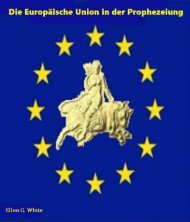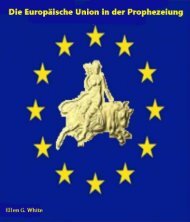- Page 3 and 4:
America in Prophecy “I beheld ano
- Page 5 and 6:
31. Evil Spirits ..................
- Page 7 and 8:
must fall the horror of great darkn
- Page 9 and 10:
and blessed of God would be ended.
- Page 11 and 12:
shall be greater than of the former
- Page 13 and 14:
the city walls, then the followers
- Page 15 and 16:
Uncontrolled passions made them tyr
- Page 17 and 18:
Terrible were the calamities that f
- Page 19 and 20:
adiant with gold, which shone dazzl
- Page 21 and 22:
tumults, conflicts, and revolutions
- Page 23 and 24:
2. Ignited Fires of Persecution Whe
- Page 25 and 26:
persecution: You may "kill us, tort
- Page 27 and 28:
themselves. The Spirit of truth rev
- Page 29 and 30:
The mysterious providence which per
- Page 31 and 32:
3. An Era of Darkness The apostle P
- Page 33 and 34:
The detector of error having been r
- Page 35 and 36:
ecome firmly established. Its seat
- Page 37 and 38:
The darkness seemed to grow moreden
- Page 39 and 40:
with the leaders of the papal hiera
- Page 41 and 42:
When the Saxons invaded Britain, he
- Page 43 and 44:
papacy were early compelled to hono
- Page 45 and 46:
their increase. Economy and severe
- Page 47 and 48:
and faithfully performed it. Conver
- Page 49 and 50:
held to be based upon falsehood. Re
- Page 51 and 52:
his bones were whitening on the spo
- Page 53 and 54:
5. Champion of Truth Before the Ref
- Page 55 and 56:
Wycliffe; but the papal leaders wer
- Page 57 and 58:
men were directed to the Source of
- Page 59 and 60:
name, may the more easily overcome
- Page 61:
his writings heretical, and, winnin
- Page 64 and 65:
the people to acknowledge. Instead
- Page 66 and 67:
6. Two Heroes The gospel had been p
- Page 68 and 69:
preachers, they proceeded to exerci
- Page 70 and 71:
that God speaking in the Bible, and
- Page 72 and 73:
In a letter addressed to his friend
- Page 74 and 75:
expecting my sentence of death tomo
- Page 76 and 77:
Huss was no more, but the truths fo
- Page 79 and 80:
spirit; but I cannot but express my
- Page 81 and 82:
ooty fell into the hands of the vic
- Page 83 and 84:
Steadfast to the gospel, the Bohemi
- Page 85 and 86:
trembling to the dark future and in
- Page 87 and 88:
Luther was ordained a priest and wa
- Page 89 and 90:
Saviour Himself declared: "I came n
- Page 91 and 92:
hearers that it was by looking away
- Page 93 and 94:
of the pope, before whom ... the ki
- Page 95 and 96:
Their union in the work added stren
- Page 97 and 98:
unreasonable, was without a single
- Page 99:
God's hands," answered Luther. "He
- Page 102 and 103:
Said Jesus to His disciples: "If ye
- Page 104 and 105:
exposed to the scorn of the wicked,
- Page 107 and 108:
immediate measures for the correcti
- Page 109 and 110:
As the Reformer proceeded on his jo
- Page 111 and 112:
Another said: "When ye shall be bro
- Page 113 and 114:
your majesty and your august highne
- Page 115 and 116:
The emperor, moved to admiration, e
- Page 117 and 118:
the Reformer as Sigismund had dealt
- Page 119 and 120:
my person and my life in the empero
- Page 121 and 122:
thoughts returned to himself, and h
- Page 123 and 124:
favor. This they endeavoured to sec
- Page 125:
"Do not imagine," he said, "that Go
- Page 128 and 129:
immediately set out to oppose him.
- Page 130 and 131:
The victories gained by the Reforma
- Page 132 and 133:
10. Reform in Germany Luther's myst
- Page 134 and 135:
The opposition of the pope and the
- Page 136 and 137:
lood. But what would have been the
- Page 138 and 139:
Satan is constantly seeking to dece
- Page 140 and 141:
Persons of all ranks were to be see
- Page 142 and 143:
11. Princely Protest One of the nob
- Page 144 and 145:
If this edict were enforced, "the R
- Page 146 and 147:
In the presence of the Diet the kin
- Page 148 and 149:
to confess energetically, freely, a
- Page 151 and 152:
"The Lutherans, according to you, a
- Page 153 and 154:
12. The French Reformation The Prot
- Page 155 and 156:
"Salvation is of grace." "The Innoc
- Page 157 and 158:
Berquin was repeatedly warned of th
- Page 159 and 160:
During the persecution of Meaux, th
- Page 161 and 162:
however, at last won his consent. "
- Page 163 and 164:
found favor. Persons of all classes
- Page 165 and 166:
character. The cruelties that were
- Page 167 and 168:
good evil, till they had fallen vic
- Page 169 and 170:
abble and beaten almost to death. Y
- Page 171 and 172:
of all the champions of popery. Cut
- Page 173 and 174:
13. The Netherlands and Scandinavia
- Page 175 and 176:
greater, and persecuting edicts fol
- Page 177 and 178:
papists to overthrow the work resul
- Page 180 and 181:
language of England among us? . . .
- Page 182 and 183:
The grand principle maintained by t
- Page 184 and 185:
Knox, vol. 2, pp. 281, 284. Such we
- Page 186 and 187:
subdue the evils of the natural hea
- Page 188 and 189:
atoning blood of Christ, and the re
- Page 190 and 191:
The Methodists of those early days-
- Page 192 and 193:
is good and acceptable in the sight
- Page 194 and 195:
avowed adherents numbered more than
- Page 196 and 197:
The periods here mentioned--"forty
- Page 198 and 199:
It had been Rome's policy, under a
- Page 200 and 201:
The "Church in the Desert," the few
- Page 202 and 203:
ought forward in full procession, t
- Page 204 and 205:
excesses are to be charged upon the
- Page 206 and 207:
The gospel would have brought to Fr
- Page 208 and 209:
they had so long paid homage, they
- Page 210 and 211:
All this was as Satan would have it
- Page 212 and 213:
will cause them to know, this once
- Page 214 and 215:
16. The Pilgrim Fathers The English
- Page 216 and 217:
His ways made known or to be made k
- Page 218 and 219:
and councils in the Roman Church; s
- Page 220 and 221:
home, in the school, and in the chu
- Page 222 and 223:
17. Heralds of the Morning One of t
- Page 224 and 225:
ighteousness and praise to spring f
- Page 226 and 227:
These signs were witnessed before t
- Page 228 and 229:
carpenter left his tools, the black
- Page 230 and 231:
planting, building, marrying, and g
- Page 232 and 233:
the day dawn, and the daystar arise
- Page 234 and 235:
Oh, what a lesson is this wonderful
- Page 236 and 237:
18. An American Reformer An Upright
- Page 238 and 239:
Miller publicly professed his faith
- Page 240 and 241:
Thessalonians, after describing the
- Page 242 and 243:
point could be found for the 2300 d
- Page 244 and 245:
THE PROPHECY OF 2,300 DAYS One Prop
- Page 246 and 247:
offered upon Calvary, ended that sy
- Page 248 and 249:
his way to turn from it; if he do n
- Page 250 and 251:
phenomenon has ever occurred in thi
- Page 252 and 253:
sayings and doctrines of men, to th
- Page 254 and 255:
Scoffers pointed to the things of n
- Page 256 and 257:
of the Sacred Word--and that the pa
- Page 258 and 259:
19. Light Through Darkness The work
- Page 260 and 261:
They performed their duty in presen
- Page 262 and 263:
The event that had filled them with
- Page 264 and 265:
His grace, with the "crown of right
- Page 266 and 267:
The disappointment also, though the
- Page 268 and 269:
papacy, which, as foretold in proph
- Page 270 and 271:
them to His first coming in humilia
- Page 272 and 273:
in my hand."-W.H.D. Adams, In Peril
- Page 274 and 275:
Bengel's writings have been spread
- Page 276 and 277:
The movement was chiefly among the
- Page 278 and 279:
Many sought the Lord with repentanc
- Page 280 and 281:
day should overtake you as a thief.
- Page 282 and 283:
But Jesus and all the heavenly host
- Page 284 and 285:
About this time a marked change was
- Page 286 and 287:
condition of worldliness and backsl
- Page 288 and 289:
eauty, and playedst the harlot beca
- Page 290 and 291:
significant question: "Did they com
- Page 292 and 293:
Says Howard Crosby: "It is a matter
- Page 294 and 295:
angel did not reach its complete fu
- Page 296 and 297:
22. Prophecies Fulfilled When the t
- Page 298 and 299:
The coming of Christ, as announced
- Page 300 and 301:
ideas and opinions above the testim
- Page 302 and 303:
Testament types also pointed to the
- Page 304 and 305:
Him whom they had pierced, there wa
- Page 306 and 307:
now. The time had passed, the Lord
- Page 308 and 309:
and rely with implicit confidence i
- Page 310 and 311:
23. What is the Sanctuary? The scri
- Page 312 and 313:
The sanctuary to which Paul here re
- Page 314 and 315:
adoration, could find, in the most
- Page 316 and 317:
The question, What is the sanctuary
- Page 318 and 319:
The whole ceremony was designed to
- Page 320 and 321:
whom the sins of the truly penitent
- Page 322 and 323:
one like the Son of man came with t
- Page 324 and 325:
Says the prophet: "Who may abide th
- Page 326 and 327:
In the parable it was those that ha
- Page 328 and 329:
It is those who by faith follow Jes
- Page 330 and 331:
25. God's Law The temple of God was
- Page 332 and 333:
of this chapter constitute a threef
- Page 334 and 335:
In contrast to those who keep the c
- Page 336 and 337:
conquest, . . . they have borne the
- Page 338 and 339:
It was apostasy that led the early
- Page 340 and 341:
Sabbath. But papists urge, as a rea
- Page 342 and 343:
would themselves form an image to t
- Page 344 and 345:
26. A Work of Reform The work of Sa
- Page 346 and 347:
These truths, as presented in Revel
- Page 348 and 349:
The majority of Adventists rejected
- Page 350 and 351:
this, those who would be loyal to t
- Page 352 and 353:
27. Revival Wherever the word of Go
- Page 354 and 355:
its name are ignorant of its princi
- Page 356 and 357:
James 2:8; 1:25. And the revelator,
- Page 358 and 359:
Scriptures teach upon this point. T
- Page 360 and 361:
time they deny the authority of the
- Page 362 and 363:
Notwithstanding these inspired decl
- Page 364 and 365:
knowledge." But the prayer of the a
- Page 366 and 367:
28. Facing Life's Record "I beheld,
- Page 368 and 369:
hearts." I Corinthians 4:5. "Behold
- Page 370 and 371:
has dishonoured their Redeemer, to
- Page 372 and 373:
As the features of the countenance
- Page 374 and 375:
make haste to confess their sins an
- Page 376 and 377:
29. Why So Much Suffering? To many
- Page 378 and 379:
plan, awakened forebodings of evil
- Page 380 and 381:
was strong. God's government includ
- Page 382 and 383:
With one accord, Satan and his host
- Page 384 and 385:
made the greatest sacrifice which l
- Page 386 and 387:
30. Infernal Enmity "I will put enm
- Page 388 and 389:
the exceeding evil and malignity of
- Page 390 and 391:
Christian imitates the divine Patte
- Page 392 and 393:
Angels are sent on missions of merc
- Page 394 and 395:
of their loss upon Jesus, he arouse
- Page 396 and 397:
32. Deadly Tricks and Snares Expose
- Page 398 and 399:
division which exist among the chur
- Page 400 and 401:
Those who are unwilling to accept t
- Page 402 and 403:
army of doubters, and he works to t
- Page 404 and 405:
ordeal of temptation, not because H
- Page 406 and 407:
33. First Great Deception With the
- Page 408 and 409:
so credulous concerning the words o
- Page 410 and 411:
abounding in compassion, is darkene
- Page 412 and 413:
abodes of bliss, there to be purifi
- Page 414 and 415:
love Him because they are drawn tow
- Page 416 and 417:
But a distinction is made between t
- Page 418 and 419:
The martyr Tyndale, referring to th
- Page 420 and 421:
classed it with the "monstrous fabl
- Page 422 and 423:
prove to be correct. Then, as confi
- Page 424 and 425:
ecomes assimilated to that which it
- Page 426 and 427:
It is true that spiritualism is now
- Page 428 and 429:
The prophet Isaiah brings to view t
- Page 430:
35. Liberty of Conscience Threatene
- Page 433 and 434:
A religion of externals is attracti
- Page 435 and 436:
Such was the fate of Rome's opponen
- Page 437 and 438:
intellectual, moral, and religious,
- Page 439 and 440:
fine for freemen and stripes in the
- Page 441 and 442:
not ignorant of the character of th
- Page 443 and 444:
which she herself employed in bygon
- Page 445 and 446:
36. The Impending Conflict From the
- Page 447 and 448:
Wherever the divine precepts are re
- Page 449 and 450:
spiritualism, and to contempt for G
- Page 451 and 452:
desolation. Even now he is at work.
- Page 453 and 454:
The dignitaries of church and state
- Page 455 and 456:
But multitudes have no more underst
- Page 457 and 458:
for themselves, they are becoming h
- Page 459 and 460:
truth depends not so much on the po
- Page 461 and 462:
psalmist: "Thy testimonies are my m
- Page 463 and 464:
Fearful is the issue to which the w
- Page 465 and 466:
As the people go to their former te
- Page 467 and 468:
tempted and tried. The Lord gives a
- Page 469 and 470: spring up and bear fruit. The publi
- Page 471 and 472: came upon Jerusalem of old. A singl
- Page 473 and 474: enemy is seeking his life, and with
- Page 475 and 476: They afflict their souls before God
- Page 477 and 478: to pray. If we allow our minds to b
- Page 479 and 480: y refusing to listen to his angels
- Page 481 and 482: abundant in goodness and truth, . .
- Page 483 and 484: arrow that flieth by day; nor for t
- Page 485 and 486: mountaintops. Soon there will be a
- Page 487 and 488: 40. Great Deliverance When the prot
- Page 489 and 490: Thick clouds still cover the sky; y
- Page 491 and 492: The voice of God is heard from heav
- Page 493 and 494: speechless now. There is the haught
- Page 495 and 496: Before entering the City of God, th
- Page 497 and 498: This reunion is witnessed by the an
- Page 499 and 500: depth and the height, of redeeming
- Page 502 and 503: The people see that they have been
- Page 505 and 506: heart, I will ascend into heaven, I
- Page 507 and 508: 42. Controversy Ended At the close
- Page 509 and 510: multitudes follow in vast companies
- Page 511 and 512: The awful spectacle appears just as
- Page 513 and 514: Again and again, in the progress of
- Page 515 and 516: "Every battle of the warrior is wit
- Page 517 and 518: which God hath prepared for them th
- Page 519: All the treasures of the universe w
- Page 523 and 524: appointed thee each day for a year.
- Page 525 and 526: An early edition is given in Migne
- Page 527 and 528: Page 65. The Sabbath Among the Wald
- Page 529 and 530: Chronicle of the Council of Constan
- Page 531 and 532: entirely wiped out."--Concil. Tolos
- Page 533 and 534: Page 284. The Atrocities of the Rei
- Page 535 and 536: of the Moslem Saracens, during the
- Page 537 and 538: 1844, made some important admission
- Page 539: pp. 226-229; S. Giacomo Baratti, La


![America in Prophecy by Ellen White [Modern Version]](https://img.yumpu.com/55888668/521/500x640/america-in-prophecy-by-ellen-white-modern-version.jpg)














